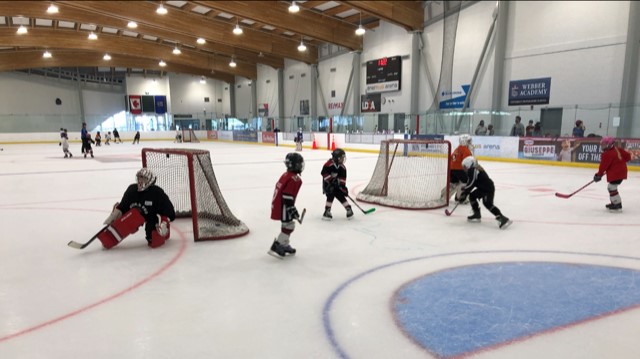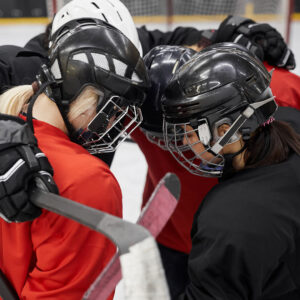We touched base with a hockey camp in Calgary to see how they’ve had to adjust to the ongoing pandemic, how their return to the ice has been, and how they’ve handled everything so far.
Reading this, we have every reason for optimism that there’s a safe way to play the game!
1. Tell us a little bit about your camp – where are you located, and how long have you been running for?
Our camp Rocky Ridge Community Hockey Camps started out as a 6-week, weekly Saturday ice skate in April/May 2018 for timbit and novice aged kids (one group). We now run holiday and spring camps that offer 3-4 ice sessions within a week over both Christmas and spring break with two groups and just held our second annual summer camp last week. All camps out of the local Rocky Ridge YMCA NW Calgary to this point.
This past week’s summer camp offered 3 age groups from timbit to bantam ages. The Beginner/Initiation/Timbit group is a 60 minute ice time while the Novice/Atom and Peewee/Bantam groups are 90 minute ice times.
The format for all groups share the same structure – 1/3 power skating instruction, 1/3 hockey skill, 1/3 cross ice games with goalies. A goalie instructor works with the goalies during power skating, skills and circulates instructing them during cross ice games, we have been graced with a guest goalie instructor (that lives across from the arena and his children participate in the camp) in Flames’ Goalie Coach Jordan Sigalet.
We use play and games whenever possible in practicing and teaching drills for both power skating and skills and then play a number of various cross ice games. Our camps are affordable most recently at $24/hour for participants on ice and we offer quality certified professional instruction.
2. How have you had to adjust to the current climate and change your protocol to account for Covid-19?
- We were given a 20-page document of protocol to follow with COVID-19 guidelines
- We had our numbers capped to 30 participants on ice including coaches and instructors
- Had our administrative work go up tenfold supplying our arena a daily list of participants with names, addresses, emails and phone numbers
- Required daily health screening tests prior to entering the arena
- No spectator rule
- Wore masks into and out of the arena
3. Are things mainly different off the ice and in the dressing rooms, or on the ice as well?
On the ice was actually close to normal, but somehow felt uncomfortable until the session started up. One big difference is no sharing water.
4. Do you find people are eager to get back into the game of hockey, or are there a lot of people waiting until this all blows over?
People were very eager, I sent out an email in early June saying there was a chance the summer camp may run and I’d let people know as soon as we got an announcement from the Arena (YMCA and City of Calgary).
The camp filled in a couple days after the email, well before the official announcement to open the rink. We had large waitlists of people wanting to register.
5. Any words for those who might be hesitant to get back onto the ice right now?
I did have one of 70 registered participants pull out due to the uncertainty of the pandemic, 2 kids in the camp came down with symptoms and pulled out. One, my own kid, had a fever the night before the camp and needed to be tested (came back negative) and a second with a stuffy nose halfway through the camp had to pull out, as well as an instructor with a runny nose pulled out after day 2. But everything has worked out very well so far!
To me as a player, parent, instructor and coach, one of the the most important parts of hockey is the social interaction, friendship part. I had parents tell me their kids were so excited to see and play with their new and old friends they couldn’t wait to get on the ice each day!
This warmed my heart as I thought kids masked coming in and going out of the arena would totally miss the social interaction camps usually provide and I in the past promoted within all the camps I ran and lead. I personally restricted any attempts to have kids interact with each other inside the arena other than partnering up for drills, the kids starving for social interaction somehow got their fill anyway just playing with other kids.


